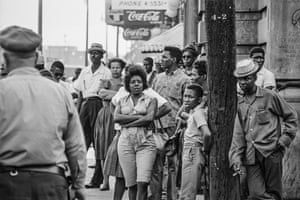Unseen photographs of civil rights conflict in Birmingham, Alabama, 1963
In spring 1963, African American civil rights activists in Alabama started the Birmingham campaign, a series of sit-ins, boycotts and marches against segregation laws. The peaceful demonstrations were met with violence, teargas and police dogs. The events were a turning point in the civil rights movement, making front-page news around the world. The Observer dispatched photographer Colin Jones to cover the story and capture the activism centred around the 16th Street Baptist church. Many of these images, discovered in the Observer’s picture archive, have never before been published.
-
Downtown Birmingham, Alabama, 9 May 1963
-
Comedian and activist Dick Gregory talks to members of the press in Birmingham on 9 May. Gregory, who was one of hundreds arrested earlier in the month while demonstrating against segregation, alleged that the police beat him while in jail on charges of ‘parading without a permit’
-
A group of policemen gathered across from the 16th Street Baptist church, which had a predominantly African American congregation and also served as a base for the civil rights movement
-
A packed meeting inside the 16th Street Baptist church, May 1963
-
-
A group of men in Kelly Ingram Park, opposite the 16th Street Baptist church
-
White supremacist city commissioner of public safety, Theophilus Eugene ‘Bull’ Connor. On 3 May, the day after the demonstrations began, Connor ordered the use of high-pressure fire hoses and police attack dogs on the young protesters. The resulting images helped swing opinion in favour of civil rights legislation. Connor remained unrepentant for the rest of his days
-
A resident of Birmingham
-
Members of the Birmingham fire department watch a group of girls cross the street
-
-
Daily life in Birmingham
-
Children sift through the wreckage of homes destroyed during the rioting that erupted following the racially motivated bombing of the nearby home of Reverend AD King, brother of Martin Luther King, and the Gaston Motel, where King and others organising the protests had stayed
-
Tension on the streets of Birmingham
-
On 8 May, Ann Stewart, 16, and Rosemary Johnson, 17, tell a news conference about the mistreatment they received following their arrests during a demonstration
-
-
Four months after this photograph was taken, on Sunday 15 September 1963, four members of the Ku Klux Klan bombed the 16th Street Baptist church, killing 14-year-olds Addie Mae Collins, Cynthia Wesley, and Carole Robertson, and 11-year-old Carol Denise McNair, and injuring 22 others. The bombing was a pivotal moment for the American civil rights movement
-
Two women walk past the area of the Gaston Motel that was dynamited by white supremacists on 11 May 1963. The motel catered specifically to African Americans and Martin Luther King had stayed in room 30, which was used for meetings of the civil rights movement’s leaders
-
Police officers in Birmingham
-
Residents gather on a street corner
-
-
A department store in downtown Birmingham
-
At a press conference on 8 May, people listen to five teenagers tell the media about their arrests and mistreatment at the hands of the police
-
These photographs are from the GNM Archive. All photographs by Colin Jones for the Observer

View all comments >